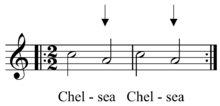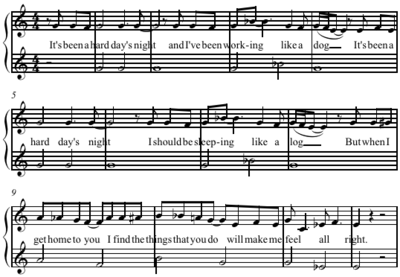- Modal frame
-
This article is about modal frames in music. For modal logic, see Kripke semantics.
In music a melodic mode [1] or modal frame is one of, "a number of types permeating and unifying African, European, and American song" and melody.[2] "Mode" and "frame" are used in this context interchangeably. Melodic modes allow melodies which are not chord-based or determined by the harmony but instead by melodic features. A note frame is a melodic mode that is atonic (without a tonic) or has an unstable tonic.
Examples and aspects of modal frames include:
- floor note
- the bottom of the frame, felt to be the lowest note though isolated notes may go lower
- ceiling note
- the top of the frame
- central note
- the center of mode, around which other notes cluster or gravitate
- chant tunes (Bob Dylan's "Subterranean Homesick Blues"[2])
- axial tunes ("A Hard Day's Night", "Peggy Sue", Marvin Gaye's "Can I Get A Witness", and Roy Milton's "Do the Hucklebuck"[2])
- oscillating (Rolling Stones' "Jumpin' Jack Flash"[2])
- open/closed (Bo Diddley's "Hey Bo Diddley"[2])
- upper or lower focus[3]
- portion of the mode on which the melody temporarily dwells
- melodic dissonance
- the quality of a note which is modally unstable and attracted to other more important tones in a non-harmonic way
- melodic triad
- arpeggiated triads which appear in a melody but not in the harmony. A non-harmonic arpeggio is an arpeggio whose notes or chord does not appear in the harmony of the accompaniment. The most common example is the melodic triad.[4]
- a temporary modal frame contrasted with another built on a different foundation note. A "change" (as in chord change) in levels is called a shift.
- co-tonic
- a melodic tonic different from and as important as the harmonic tonic
- secondary tonic
- a melodic tonic, though different from and subordinate to the harmonic tonic
- pendular third[5]
- alternating notes a third apart, most often a neutral, see double tonic
Other songs with modal frames indicated are "A Day in the Life" and "My Generation".[2]
Example
The modal frame of The Beatles' "A Hard Day's Night" features a ladder of thirds axially centered on G with a ceiling note of B♭ and floor note of E[♭] (the low C being a passing tone):[2]
"A Hard Day's Night" modal frame.[2]
According to Middleton, the song, "at first glance major-key-with-modal-touches", reveals through its "Line of Latent Mode" "a deep kinship with typical blues melodic structures: it is centred on three of the notes of the minor-pentatonic mode [on C: C, E-flat, F, G, B-flat] (E♭-G-B♭), with the contradictory major seventh (B♮) set against that. Moreover, the shape assumed by these notes - the modal frame - as well as the abstract scale they represent, is revealed, too; and this - an initial, repeated circling round the dominant (G), with an excursion to its minor third (B♭), 'answered' by a fall to the 'symmetrical' minor third of the tonic (E♭) - is a common pattern in blues."[6]
See also
Sources
- ^ van der Merwe, Peter (1989). Origins of the Popular Style: The Antecedents of Twentieth-Century Popular Music. Oxford: Clarendon Press. pp. 102–103. ISBN 0-19-316121-4.
- ^ a b c d e f g h Middleton, Richard (1990/2002). Studying Popular Music, p.203. Philadelphia: Open University Press. ISBN 0335152759.
- ^ adapted from Ekueme, Lazarus. cited in Middleton (1990), p.203.
- ^ van der Merwe (1989), p.321.
- ^ adapted from Nketia, J.H. cited in Middleton (1990), p.203.
- ^ Middleton (1990), p.201.
Categories:- Modal frames
- Musical techniques
Wikimedia Foundation. 2010.


